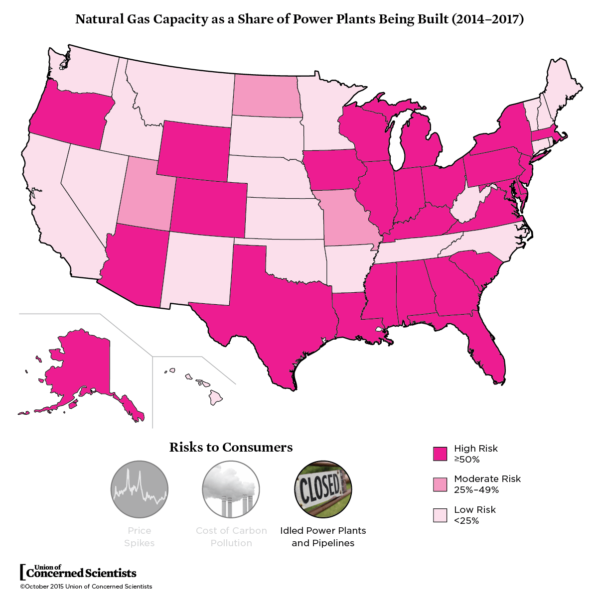Alongside photos of the local apple festival and headlines about the school budget, recently the front page of my small town’s weekly newspaper has been full of talk about natural gas pipelines and “eminent domain” and even FERC, the federal agency that approves (or not) new interstate pipelines. And it’s not just us. It turns out a lot of places are thinking about natural gas these days, including for electricity generation.
A logical question for each of us as consumers might be: Is my state betting too much on natural gas for electricity? That’s what a new UCS analysis set out to examine. Here’s what’s clear, what’s surprising, and what’s next.

Our new analysis, Rating the States on Their Risk of Natural Gas Overreliance, assesses each state using a range of measures of overreliance, with a focus on consumer risks.
For consumers, overreliance can be bad news because it increases their odds of having to pay for price spikes, carbon pollution, and idled plants down the road.
The Rating the States metrics look at each state’s natural gas generation, natural gas capacity (how many megawatts their power plants add up to), and power sector carbon emissions. Each metric separated states into low, moderate, or high risk groupings for each metric.
What’s clear
One thing that’s clear is that there are a lot of states with a lot of signs of natural gas overreliance.
- Overall, we found that two-thirds of states showed signs of risk of overreliance.
- 16 states earned “High” ratings in at least three metrics. Those states were all over the map (literally)—from the West Coast to the East, from the Great Lakes to the Gulf.
- In 8 states, natural gas accounts for at least half of in-state electricity generation. It’s good to keep a multi-metric perspective, to look at the various ratings as painting a picture of potential overreliance. But that particular indicator seems pretty stark, in small states and some big ones.
What’s surprising
When you do this type of analysis, you may find some surprising stats, unexpected results. And we certainly did in this one.

One of the Rating the States metrics looked at where natural gas is already a big part of in-state electricity generation.
- One result in our analysis that really stands out concerns what’s being built, power plant-wise. We found that natural gas accounts for at least 90 percent of power plant capacity being built (2014-2017) in 10 states—including 100 percent in 3 of those states.
- It might be surprising, too, to see states showing up that currently have very little in-state natural gas electricity generation. Some states are clearly in the thick of moving toward a lower-carbon power mix. Other states are going to have to start that process, and soon. For utilities and regulators in those states, natural gas might seem like a ready substitute as they phase out coal. But there are problems with that approach, including with regard to climate change. That’s where the risk of overreliance comes in.
- Overreliance risks for other states are, if not surprising, at least hidden. Our analysis looked at natural gas within a state’s border, so some states may be less reliant on gas than their in-state figures suggest. But other states, without much natural gas going on at home, aren’t necessarily out of the woods. Vermont and New Hampshire, for example, don’t have much natural gas within their boundaries, but they’re dependent on a regional power grid where close to half of electricity generation is from gas. So their electricity consumers could still be at risk.
What’s next
Given risks of natural gas overreliance, the question is what states can do and are going to do about it to improve the odds for their consumers when it comes to financial risks. The great news is that we have lots of options to choose from.

Another metric looked at where states are placing their bets; natural gas turns out to be a big chunk of what’s getting built in a lot of states.
- Some states are embracing renewable energy and energy efficiency in a big way, seeing in them potential not just to move away from fossil fuels but also to build clean energy economies.
- The new Clean Power Plan is a big opportunity to make smart choices about natural gas.
- And states can avoid natural gas investments that aren’t going to pay off in the long term, and look instead for options for power plants and gas supplies at appropriate scales and with enough flexibility to complement clean energy development rather than hampering it.
Expanding renewables and efficiency gives consumers better odds and leads to deeper carbon reductions. So what’s it going to be? Will your state play its cards right?

